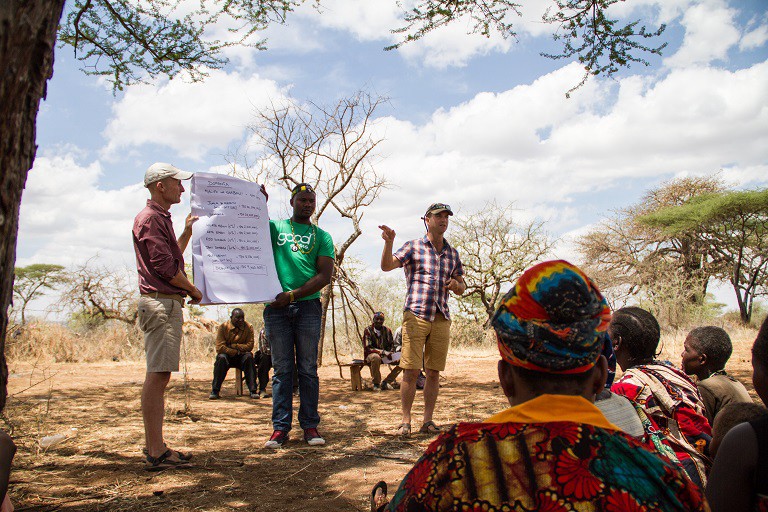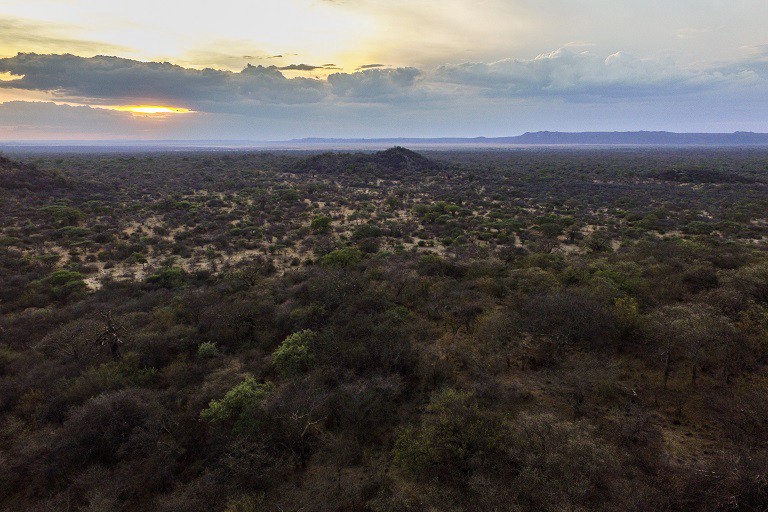Yaeda Valley in Tanzania is home to the Hadzabe, one of the last remaining hunter-gatherer tribes in the world, and they are using carbon trading to save their forests.
By Sophie Tremblay & Willy Lowry
Hadzabe walinzi wa jadi, or village game scouts patrol the forests of the Yaeda Valley. Their job is to patrol protected forests and report any deforestation, poaching, or creation of settlements to local authorities. Their salary is paid by Carbon Tanzania from revenue made from carbon sales. (Photo: Sophie Tremblay/Mongabay)
YAEDA VALLEY, TANZANIA — “Carbon,” says Mzee Sinze while sitting in the shade of an ancient, giant Baobab tree. “Carbon is very important to us Hadzabe.”
It’s not the answer one might expect from a tribal elder when asked why the forest is important to the hunter-gatherer Hadzabe tribe. But Sinze has a good reason for his statement.
“When you look around you see these beautiful trees and they belong to the Hadzabe,” he says. “From the mountains all around you can see the forest and this is because of carbon.”
Nestled between two rocky escarpments, the Yaeda Valley in Tanzania is home to the Hadzabe, one of the last remaining hunter-gatherer tribes in the world. The landscape is part of the Great Rift Valley that slices its way through much of the continent. Anthropologists believe the tribe has roamed the valley floor and surrounding acacia woodland for more than 40,000 years.
“Our work is contributing to the campaign of helping to reduce climate change that is bad to the life of the people and other living creatures all over the world.”
The Hadzabe are deeply connected to their environment — they survive by collecting fruits, seeds, honey, and roots and hunting animals from buffalos to baboons. They live in small camps and move around the forest depending on the season. But since the 1960s, according to experts the forest accessible to the Hadzabe has shrunk by 90 percent, threatening the traditional lifestyle of the 1,000 to 1,500 remaining members.
“It’s not the same as we used to live before. The environment is being destroyed,” Sinze says. “During our parents’ time there used to be lots of animals around. My old man used to roam for just a little while in the forest and come back with a big antelope.”
Sinze says the pressure on the valley came from the increasing number of Datooga, a pastoralist tribe, whose cows and goats overgrazed the land leaving little food and water for the herbivores the Hadzabe hunt, and the Sukuma, an agriculturalist tribe who Sinze says cut down trees to make farms.
Conservation Intervention
In 2007, the threats to the Hadzabe and the Yaeda Valley caught the attention of two conservationists, Marc Baker and Jo Anderson.
“The main threats to this landscape — and this is pretty typical across Tanzania — are economic migrants,” Baker says. “People moving, because the landscapes in which they have lived unsustainably for many years are collapsing.”
Ground surveys and satellite imagery suggested the Yaeda Valley was losing 191 hectares or 0.93 percent of forest every year.
“At the time, the mechanism for REDD (reducing emissions from deforestation and forest degradation) was developing in an academic sense, and we recognized this model immediately,” Baker explains. “You could reduce deforestation by creating a steady flow of revenue based on land-use planning and participatory forest management.”
In 2010, Baker and Anderson co-founded Carbon Tanzania, a social enterprise to help the Hadzabe benefit from REDD carbon trading.
Communal Land Rights
At the same time Carbon Tanzania was founded the Ujamaa Community Resource Team, a group that fights to secure land rights for indigenous communities in Tanzania, was working with the Hadzabe and local government in the Yaeda Valley on a plan to ensure the Hadzabe owned their land.
Alongside Carbon Tanzania, they were able to create the first community Certificate of Customary Right of Occupancy (CCRO) in Tanzania — a landmark legal decision that gave the Hadzabe, as a group, ownership of 20,000 hectares of land in the Yaeda Valley. It also allowed the Hadzabe to create their own by-laws for how the land should be used.

Jo Anderson, co-founder and director of finance and sales at Carbon Tanzania, presents the bi-annual profits from carbon sales during a community meeting in Monga Wa Mono village in Yaeda Valley. It is up to the community to decide how to spend the money. (Photo: Sophie Tremblay/Mongabay)
Instead of kicking out the Datooga and Sukuma, the community worked together to zone the valley for different land uses. Swampy areas with nutritious grass were zoned for the pastoralists. Areas with rich soil were set aside for farming and the rocky hills and natural forests were designated as areas for wildlife and traditional use by the Hadzabe.
“What tends to happen is that the land that is cleared for agriculture is not always suitable for farming — so there’s a loss of habitat without any gain in agricultural production. So what we’re trying to do is put a value on land that is better left forested rather than poorly farmed,” Anderson says.
Carbon Trading Begins
In 2011, the Hadzabe signed a 20-year contract with Carbon Tanzania to sell forest carbon offsets on their behalf. Before trading could begin, the amount of carbon stored in the Yaeda Valley needed to be counted. Along with the Nature Conservancy, Hadzabe members and Carbon Tanzania undertook the task of measuring the area’s carbon reserves through aboveground biomass surveys and Landsat and Google Earth satellite imagery.
They found that each hectare of the acacia woodland stored around 116 metric tons of carbon dioxide. That’s the equivalent of greenhouse gas emissions from 25 passenger cars driven for an entire year.
Carbon Tanzania registered the project with Plan Vivo Foundation, an organization that certifies fairly traded carbon initiatives.
“As soon as we set up, we internalized the need to be able to monetize the ‘carbon saving’ that is produced by this project,” Baker says. He and Anderson approached local and international companies seeking to reduce their carbon footprint and began selling carbon offsets.
Revenue for Communities
Today, Carbon Tanzania’s Yaeda Valley project covers 31,930 hectares of forest and counts 16,011 tons of sequestered carbon annually — the equivalent of taking 3,300 passenger cars off the road for a year.
Revenue from their sales is used to ensure the forests are properly protected. Carbon Tanzania pays Hadzabe villagers, like Sinze, a monthly salary to patrol the forests and make sure there have been no new encroachments or cutting of trees.

Jo Anderson, co-founder and director of finance and sales at Carbon Tanzania, presents the bi-annual profits from carbon sales during a community meeting in Monga Wa Mono village in Yaeda Valley. It is up to the community to decide how to spend the money. (Photo: Sophie Tremblay/Mongabay)
“Whenever I find trees cut down I must report that to the authorities,” Sinze says. “When I get to the leaders I tell them there is something wrong. I take them to the affected area and we try to find out who is cutting these trees so we can arrest them.”
Sinze and the other scouts make 50,000 Tanzanian Shillings per month ($23) which he says they usually spend on food like maize to supplement their diet in times of need, as well as on clothes for their families.
In addition to the money Carbon Tanzania uses to operate the project, 60 percent of the revenue from the carbon offset sales is paid directly to the community. To date, $150,000 has been paid to the villages of Domanga and Mongo wa Mono in the Yaeda Valley. Every six months, the villages hold meetings with the entire community to decide how to spend their money.
Some REDD projects have failed in Tanzania due to funding uncertainties and low carbon prices. The complexities have meant greater profit could come from cutting down trees in rural areas to expand farmland than to leave them alone for carbon sequestration.
But Baker and Anderson say the REDD approach is working in the Yaeda Valley and they’ve been able to tap into both the local and global voluntary offset market.
“What we’re saying to companies and individuals is take the step to reduce your impact on the natural world by supporting the conservation of this natural habitat which also supports the lifestyle of a very special indigenous cultural group,” Anderson says.
Local Action, Global Impact
“In this current world, global climate change is a hot issue,” says Issac Bryceson, Carbon Tanzania’s project manager, who is from the Yaeda Valley. “Our work is contributing to the campaign of helping to reduce climate change that is bad to the life of the people and other living creatures all over the world.”

A drone’s view of the Yaeda Valley in northern Tanzania. The valley is part of the Great Rift Valley landscape. These Acacia-Commiphora woodlands are home to the Hadzabe people. (Photo: Willy Lowry/Mongabay)
By keeping trees in the ground, carbon dioxide is absorbed and stored in the trees. When the trees are cut down the stored carbon is released into the atmosphere. According to the United Nations Environmental Programme, deforestation and forest degradation account for nearly 17 percent of global greenhouse gas emissions.
“There is no factory or industry in this valley, so carbon gases that have been reduced in this conservation area come from far away, from these industrial countries,” Bryceson says. “We beg those people to support us in this issue of conserving our forest resources so that we can continue our permanent life like we want here in Yaeda Valley.”
Expansion Plans
Carbon Tanzania is now in the process of setting up two new REDD+ projects to help other local communities in Tanzania. The first is in the Makame Wildlife Management Area, a region that supports both Maasai pastoralists and wildlife populations. The second is east of Mahale Mountains National Park in northwest Tanzania, which holds the largest known population of Eastern Chimpanzee. The project would help protect the populations of Chimpanzees which live outside the park. Both areas are facing rapidly increasing rates of deforestation.
Though Carbon Tanzania currently relies on personal and corporate social responsibility rather than a compliance or legal mechanism, Baker and Anderson hope that global climate deals like the Paris Agreement will help increase their sales.
The Makame and Mahale projects are being developed as Jurisdictional REDD+ projects, which means they could eventually be considered under a government scheme, and thus could qualify for the Paris Agreement and the International Civil Aviation Organization’s carbon offsetting scheme.
“If a country like Tanzania can develop its rural economy based on increasing forest conservation which keeps carbon dioxide in the ground, benefits the global agreement, and creates a green economy, then that’s a win-win for all,” Baker says.
This story originally appeared at the website of global conservation news service Mongabay.com. Get updates on their stories delivered to your inbox, or follow @Mongabay on Facebook, Instagram, or Twitter.





